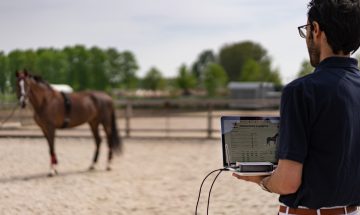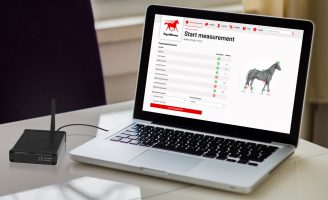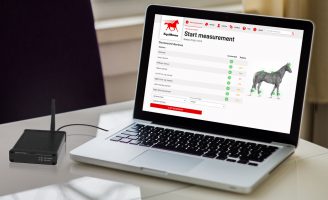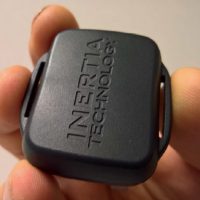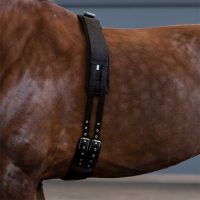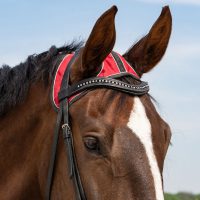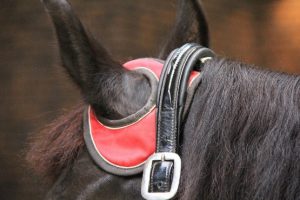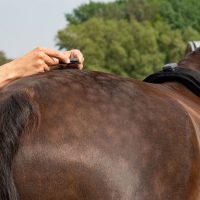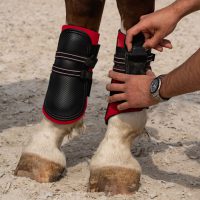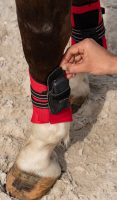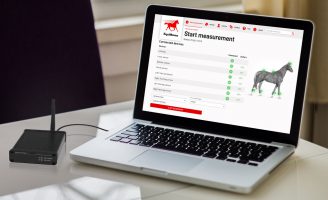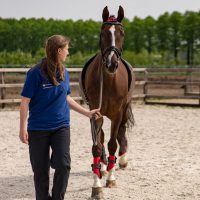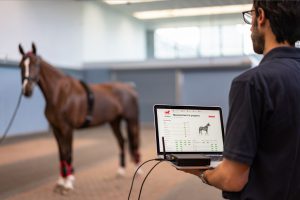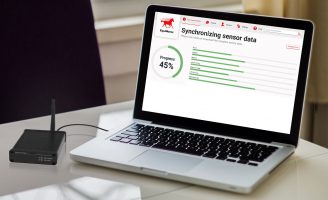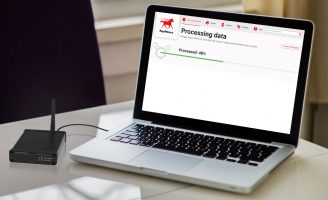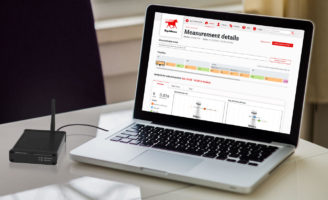How it works
In order to capture motion data, wireless inertial sensors are attached to the legs, the withers, the sacrum and the head of the horse.
The sensor data is streamed to a gateway connected to the computer. The EquiMoves motion processing software computes the relevant parameters and analyzes the horse’s gait for lameness and performance assessment.
Placing sensors is a completely non-invasive procedure. They do not disturb the normal movement pattern of the horse.
EquiMoves is very easy to use
- You can use the system wirelessly.
- You can start or stop measurements anytime during the normal procedure of the lameness exam.
- You can evaluate the horses in hand, ridden or driven.
- The workflow is designed to interfere as little as possible with the clinical lameness exam.
Sensor Installation & Measurement Process
Step 1
Connect the gateway to the laptop using a USB-cable. The power light of the gateway turns blue. In the “Start measurement” screen the gateway connection status changes from to .
Step 2
Turn the sensors on by pressing the power button. The blue LED of the power button of each sensor starts blinking. Enter the application. In the “Start measurement” screen, check that the sensors are connected to the gateway and the status icon is .
The sensors themselves also show that they are connected: the blue LED of the power button blinks twice. Make sure the sensors have enough battery. A green color of the battery status indicator (e.g. 85%) is ideal for a lameness examination. An orange color (e.g. 20%) is also in principle sufficient for an examination. The red color (e.g. 5%) signifies that the battery should be charged before the test.
Step 3
Fix the withers sensor to the girth with the power button pointing caudal. Attach the girth to the horse. Check if the withers sensor is on the mid-line of the horse.
Step 4
Attach the head sensor to the headpiece with the power button pointing caudal. Put the headpiece on the horse. Use a bridle to tightly secure the head sensor and to make sure it does not move during the examination.
Step 5
Stick a few centimeters of double sided adhesive tape on the sacrum sensor. Locate the tuber sacrale of the horse. Fix the sensor to the skin between the left and right tuber sacrale with the power button pointing caudal.
Step 6
Attach the brushing boots to the horse. Be careful, as the horse may kick! Put the sensors in their holders with the power buttons facing up and the Inertia logo facing laterally. Place the sensor holders on the lateral side of the brushing boots. Check if the sensor holders are aligned with the cannon bone and on the mid-line of the leg.
Step 7
Lead the horse to the start location of the examination, as close as possible the gateway. Check that all sensors are still connected to the gateway. Place the gateway higher up from the ground and try to maintain a line of sight between the gateway and the horse.
Step 8
Press the “Start measurement” button. Let the horse stand still for 5 seconds. Then start the examination.
Step 9
Guide the horse back close to the gateway. Let the horse stand still for 5 seconds. Check again that all sensors are connected to the gateway. If not, wait for all of them to reconnect. After that, press the “Stop measurement” button to end the measurement. Wait until the data is synchronized. This can take up to a few minutes.
Step 10
Wait for the data to be processed. This can take up to a few minutes. Check the results of the lameness examination. You can choose to make a report for the owner.
Request more information
If you are interested in using EquiMoves in your activities please send us a message and we will be happy to give you more information.
EquiMoves used in breeding
Friesians In 2010, John Voskamp and Wim Back, nowadays board member of KFPS (Royal Friesian Studbook) initiated research using inertial sensors for the KFPS. These initial trials at Stoeterij Koningsland marked the beginning of EquiMoves’ development for analyzing… Read more →
EquiMoves as a tool to detect lameness – RTV Utrecht
In an ample reportage at RTV Utrecht, the broadcaster of the province of Utrecht, the practice at the veterinary clinic of Utrecht University is presented in detail. Technology is used by both veterinarians and researchers to examine the… Read more →
Using Different Combinations of Body-Mounted IMU Sensors to Estimate Speed of Horses – A Machine Learning Approach
Hamed Darbandi, Filipe Serra Bragança, Berend Jan van der Zwaag, John Voskamp, Annik Imogen Gmel, Eyrún Halla Haraldsdóttir and Paul Havinga Sensors 2021, 21(3), 798; https://doi.org/10.3390/s21030798 Speed is an essential parameter in biomechanical analysis and general locomotion research.… Read more →

